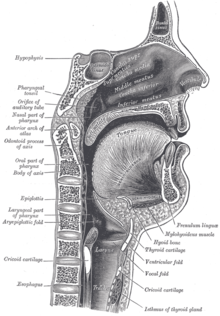Oral care
In professional care, the term oral care is a combination of actions to prevent or treat inflammation or injuries to the oral environment and the mucous membrane of the mouth and throat . In nursing , care for the elderly and palliative care , mouth moistening relieves dry mouth and feelings of thirst ; With further oral care measures, however, other complaints - such as increased salivation, fungal infections in the mouth and bad breath - can also be counteracted.
The brushing or dental cleaning, including oral hygiene to dental prophylaxis called, is indeed a part, but not the aim and the subject matter of the oral care in the nursing field.
Affected group of people
Particular attention must be paid to regular oral care, though
- the person does not eat any orally and therefore does not chew, so that saliva production is not sufficiently stimulated (for example because of food abstinence, tube feeding, parenteral nutrition).
- the person is unable to provide thorough oral care due to physical or mental impairment (for example, fractures in both hands or arms).
- There is a risk of aspiration (for example, if the irrigation solution cannot be spat out again, as in the case of high paraplegia , unconsciousness , ventilation ).
- Endotracheal intubation must be prepared preoperatively .
- There are diseases of the oral cavity that require special care (e.g. therapy and care of (chronic) tonsillitis , thrush ).
- the person is dying .
Oral care is only taken over by caregivers if the measures cannot be carried out by the person concerned.
Oral Care Goals
The goals of oral care result from the individual situation of the person in need of support.
The oral cavity continues into both the digestive tract and the respiratory tract . Both tube-like hollow organs are to be protected from contamination . The focus is on preventing parotitis and, in ventilated patients, avoiding aspiration pneumonia . In general, a moist, clean mucous membrane, plaque-free teeth, subjective well-being, the prevention of thrush , pain, dehydration and possibly the introduction of medication should be mentioned. The frequency and scope of the measures depend on the respective goal, but also on the condition and will of the person concerned.
activities
That personnel initially takes an inspection of the oral environment and oral cavity before, usually with the aid of a spatula and a small light source; you have to proceed carefully so as not to trigger gag reflex. In people who are not fed oral nutrition, the parotid glands (parotid glands) are palpated ; Expressions of pain can indicate inflammation (parotitis). The treating doctor or dentist must be informed of any inflammatory changes. The updating of the nursing plan (evaluation) is carried out by the nurse.
In principle, chewing should be encouraged. It massages the ducts of the parotid glands and thus ensures saliva production. Inadequate salivation and poor oral hygiene can cause unpleasant symptoms that may affect eating or speaking. For patients with a dry mouth (for example due to medication or if their fluid intake is restricted), sucking sour candy or chewing dried fruit, chewing gums or fruit gums can be an alternative to medical rinsing solutions.
If necessary, the person in need of support can carry out further measures himself - according to instructions or with assistance. If oral care is taken over by a nurse or a nurse , it must be taken into account that this involves an intervention in one of the intimate areas of the person, which may not be tolerated. Other measures include
- cleaning the teeth or the dentures .
- the softening or removal of bark and coverings
- moistening the mucous membranes with suitable solutions; when choosing, the taste of the patient is taken into account
- Drying the mouth with cotton swabs and suctioning off the oral cavity in the event of increased saliva secretion
- the application or introduction of medicinal preparations (local therapeutic agents), for example a local anesthetic for painful fissures or mucositis
- Corner and lip care (for example with dexpanthenol ointment or petroleum jelly ).
As part of a remediation in the case of colonization with multi-resistant germs in the nasopharynx or in the case of fungal infestation (thrush), disposable toothbrushes are used to prevent new infections. If there is an increased tendency to bleeding gums (for example in the case of coagulation disorders), brushing the teeth is avoided.
If a humidifier is used, it must be checked by a qualified person before installation if it is an active medical device . With thermal devices, a sufficient safety distance must be observed.
See also
- Prophylaxis (dentistry)
- Individual prophylaxis
- breathing
- Basal stimulation
- Desiccosis
- Hypersalivation
- Swallowing act
- Tonsil stone
literature
- Beate Augustyn, Martina Kern: Nursing measures in symptom treatment. In: Eberhard Aulbert u. a. (Ed.): Textbook of palliative medicine. Schattauer, Stuttgart 1997; 3rd, updated edition, ibid. 2012, ISBN 978-3-7945-2666-6 , pp. 948–958, here: pp. 948–950.
- Claudia Bausewein , Susanne Roller, Raymond Voltz (Eds.): Guide to Palliative Care. Palliative Medicine and Hospice Care. 5th edition. Elsevier, Munich 2015, ISBN 978-3-437-23313-5 , pp. 146–155.
- Susanne Schewior-Popp , F. Sitzmann, L. Ullrich (eds.): Thiemes care. Georg Thieme Verlag, Stuttgart 2009, ISBN 978-3-13-500011-4 , pp. 327-332 and pp. 1394-1396.
Web links
- Guidelines of the DGP Care Section: Oral care in the last phase of life. (As of November 2014)
- Twelve short films by the German Dental Association and the Center for Quality in Care (ZQP) Dental care for people in need of care and people with disabilities
Individual evidence
- ↑ Renate Langenbach, Ilse Delagardelle: Affects der Mundschlimheit . In: Eberhard Aulbert, Friedemann Nauck, Lukas Radbruch (eds.): Textbook of palliative medicine. 2012, pp. 265–270, here: p. 266.
